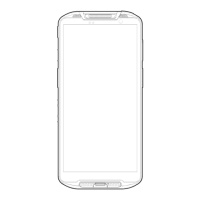PM95 Android 13 User Manual
89
© 2024 Point Mobile Co., Ltd. All rights reserved
Safety Information
Battery Safety Information
Follow the battery safety guidelines for safe usage, storage, and disposal of Li-ion batteries. Improper battery
use may result in a fire, explosion, or other critical hazards.
Battery Safety Guidelines
Use only Point Mobile approved batteries and charging accessories. Other batteries and chargers may
damage the device or result in a fire, leakage, or other hazards.
Do not expose the battery to excessive heat or cold.
Do not use or store the battery in or near areas that might get very hot, such as in a parked vehicle, near
a heat duct or close to other heat sources.
Do not allow objects that may cause a short circuit, such as metal objects, corrosive substances, or
liquids like water, to contact the battery.
Do not disassemble, crush, bend, shred, press, or other actions that may damage or deform the battery.
Do not use or replace the battery on the go or from a high location. Dropping may result in an explosion or
fire.
Do not put any labels, stickers, tags, etc. on the device or battery. Performance of the device or battery,
such as sealing, drop, or tumble, could be affected.
Close supervision is necessary when used near children to avoid the risk of injury.
If battery leakage is observed, avoid any contact with the skin or eyes and properly dispose of the battery.
If contact has been made, wash the affected area with water for 15 minutes and seek medical advice.
If you notice any type of damage to the battery, such as swelling, dents, and leaks, stop using it
immediately and contact Point Mobile.
Battery Charging Guidelines
Charge the battery in a clean, cool, dry, and ventilated environment.
Separate the charger from the battery as soon as possible when the battery is fully charged.
Battery performance can degrade due to the stress of daily charging and discharging. Batteries typically
need to be replaced after 300 to 500 charging cycles (full charge-discharge cycles) or when the battery
capacity has been reduced to 70 ~ 80% of its original capacity. The actual number of charging cycles
varies based on usage patterns, temperature, age, and other factors.

